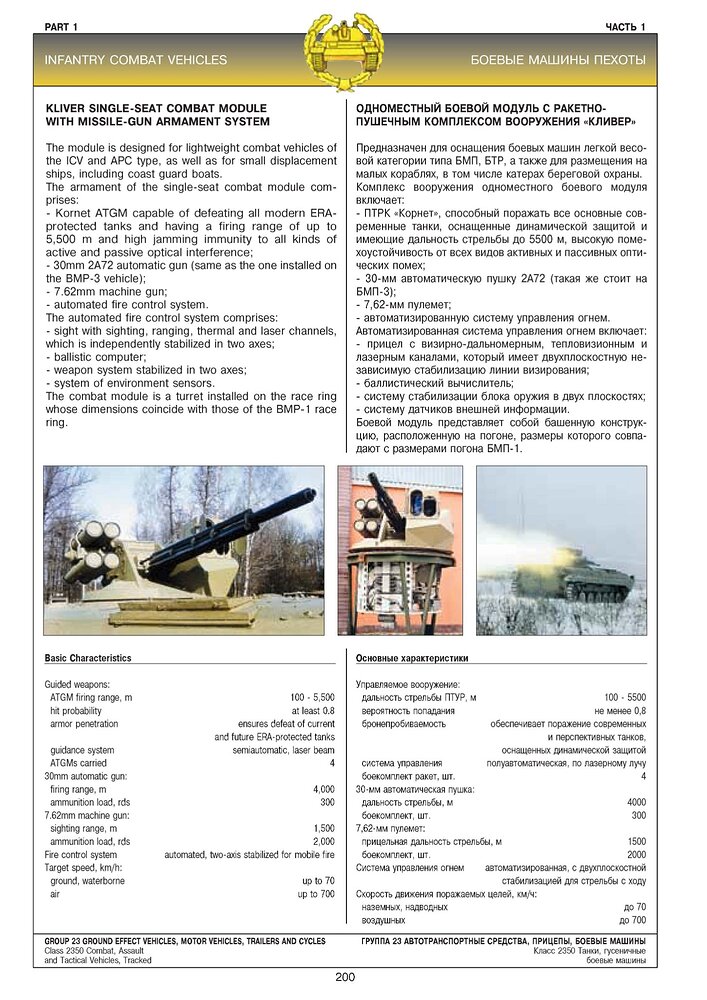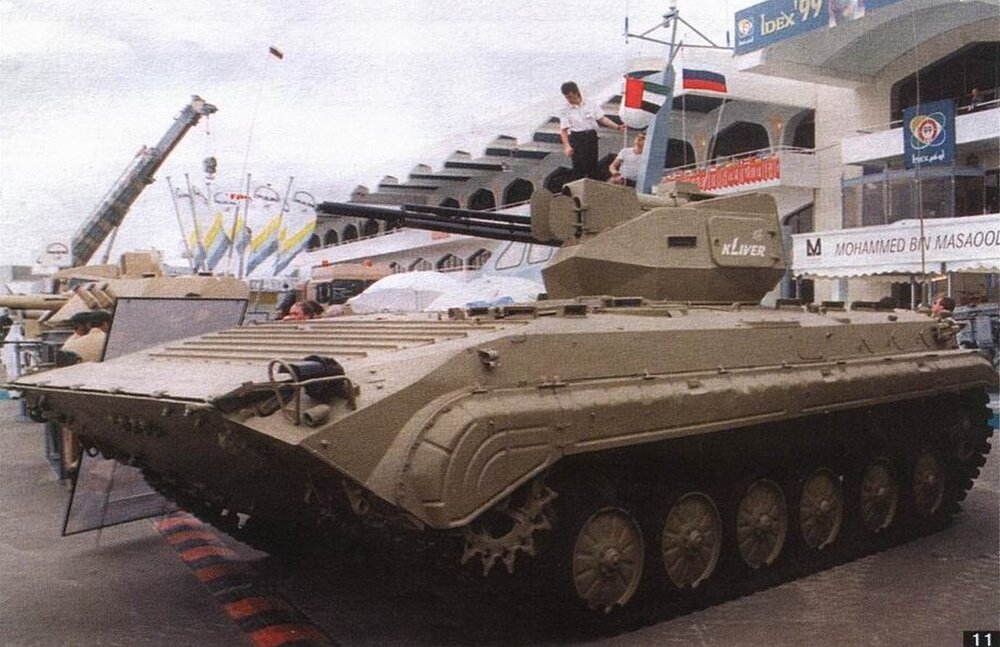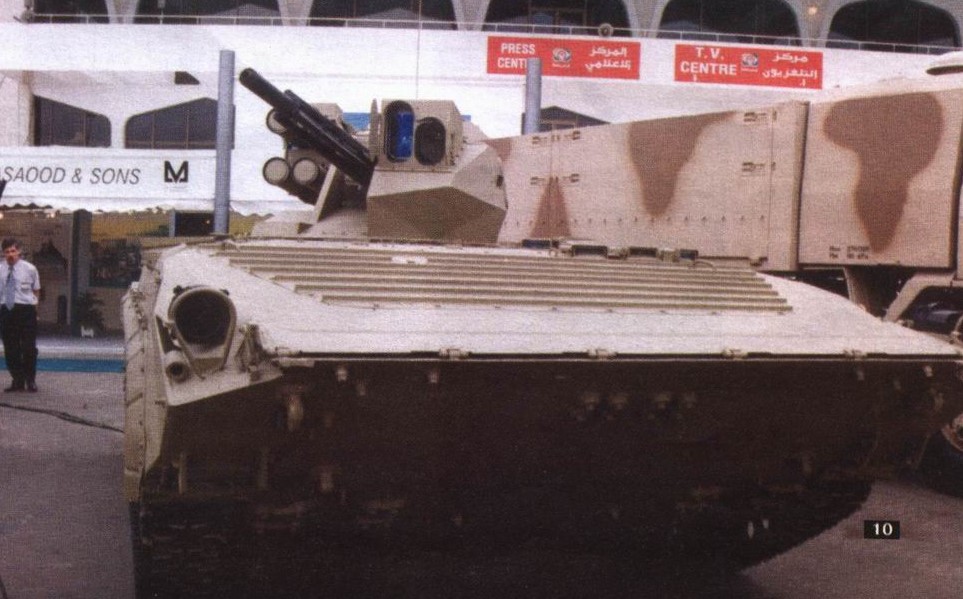- Yes
- No
Welcome to the suggestion post for the BMP-1 Kliver! This is a Russian IFV marketed in the 1990s for the export market. It would be accurate to say that it is a turret, as the hull is a simple BMP-1, but the turret is where all of the changes are. The TKB-799 ‘Kliver’ turret is a weapons station with a 30mm 2A72 autocannon, four Kornet anti-tank missiles, and a 7.62mm machine gun. Internally, the turret offers thermal imaging and stabilization, improving the combat performance of vehicles it is mounted on. While this vehicle did not see any service in real life, this doesn’t have to be the case in War Thunder. In-game, the BMP-1 Kliver could serve as a tech tree counterpart to the BMP-2M, offering similar armament on a familiar chassis.
History
Soviet BMP-1s in Afghanistan, 1988. The BMP-1 was a mainstay for the USSR during the Cold War, and was widely exported.With the collapse of the Soviet Union in 1991, the subsequent economic instability faced by the Russian Federation necessitated a slowdown in the production of newer vehicles. As a result, the Russian Army continued to maintain a significant number of older vehicles in its inventory, while Russian design bureaus shifted their focus towards the export market.
One of these design bureaus was the KBP Instrument Design Bureau, located in Tula, which had made substantial contributions to Russian weapon designs. Notable among their achievements were the development of the 23mm ZU-23-2 anti-aircraft autocannon, the 30mm 2A42 and 2A72 autocannons used on the BMP-2 and BMP-3 vehicles, the 73mm 2A28 Grom used on the BMP-1, the 9M113 Konkurs anti-tank guided missile, and the 2K22 Tunguska anti-aircraft system, among others.
A drawing of the Kliver turret, showing the different features and notable weapon systems available.In the mid-1990s, KBP embarked on the development of a lightweight turret that could be fitted to infantry fighting vehicles, armored personnel carriers, and even small ships if required. During this period, KBP was also finalizing the design of a modern anti-tank guided missile, which would later be known as the 9M133 Kornet. The intention was to incorporate this advanced missile system into the new turret design, providing potential export customers with access to the latest Russian anti-tank technology while also upgrading their existing vehicles. The resulting turret design was designated as TKB-799 and earned the nickname “Kliver” or “Cleaver.” Prior to its first public showcase in Tula in 1996, the Kliver turret underwent testing on a BTR-80 chassis, demonstrating its compatibility and adaptability.
A BTR-80 fitted with the Kliver turret during a public exhibition in Tula, 1996.The new turret represented a remarkable leap in modern technology. The Kliver, equipped with its own turret basket, was designed as a versatile weapon station to be installed in various vehicles. It boasted a versatile weapons station equipped with three distinct armaments. First and foremost, a 30mm 2A72 autocannon was integrated, alongside a 7.62mm PKT machine gun. Notably, the turret also featured a quadruple configuration of 9M133 Kornet-E missiles, prominently positioned beside the autocannon. The 2A72 autocannon possessed an impressive range of capabilities, including the ability to fire 3UOF8 high explosive, 3UBR6 armor piercing, and 3UBR8 armor piercing discarding sabot rounds at a steady rate of fire of 350 to 400 rounds per minute. Furthermore, the Kornet missiles introduced an extremely modern design, utilizing a 152mm tandem charge warhead capable of penetrating 1,200mm of armor as far as 5,500 meters away.
In addition to its impressive armament, the turret incorporated a range of advanced systems. Notably, the fire control system stood out, offering a dual-axis stabilization mechanism for the gunner. It further featured a state-of-the-art day/night sight, utilizing a thermal imaging channel to enhance visibility in all lighting conditions. Moreover, a laser rangefinder was incorporated, enhancing the turret’s precision and target acquisition capabilities. These combined systems provided a formidable advantage in combat scenarios. The turret showcased an advanced electromechanical firing system that operated automatically. This system encompassed sighting, ranging, and precise weapon laying capabilities, incorporating lead, elevation, and traverse adjustments. These enhancements significantly improved accuracy, especially when engaging moving targets. Moreover, the turret was thoughtfully designed to offer ample elevation angles, ranging from -10º to +60°. This feature enabled the turret to possess moderate anti-aircraft capabilities, particularly in countering helicopters.
A BMP-1 Kliver at an IDEX exhibition in Abu Dhabi, late 1990s.Despite the BTR-80 being the first vehicle to incorporate the Kliver turret, it was the BMP-1 that received the most attention as the primary platform. The Kliver turret on the BMP-1 made its debut at an International Defense Exhibition in Abu Dhabi in 1997, where two vehicles were showcased with the turret for promotional purposes. KBP launched an extensive marketing campaign to sell the turret for both domestic and international BMP-1 fleets, with multiple demonstrations held in Russia and abroad. The turret designers even claimed superiority over the turrets found on the BMP-1, BMP-2, M2 and M3 Bradley, and the Marder IFV. While their claim was not entirely unfounded, a significant issue arose with the combination of the BMP-1 and Kliver turret – the aging and inadequacies of the BMP-1 itself.
By the late-1990s, the BMP-1 had become outdated and garnered a reputation for its cramped interior, insufficient armor, and obsolete features like firing ports. Although KBP offered a modern turret solution, they did not provide an upgrade option for the BMP-1 itself, as their primary focus was on weapon design rather than vehicles. This limitation may not have posed a problem for existing BMP-1 users, but it remains unknown as no country, including Russia, ended up purchasing the TKB-799 Kliver turret. Eventually, the BMP-1 received a new turret in the form of the BMP-1AM, while the BTR-80 underwent successful upgrades to the BTR-80A and later the BTR-82A, each offering substantial modernizations. Presently, the legacy of the Kliver lives on in other turret designs such as the B05Ya01 Berezhok turret, also manufactured by KBP.
A BMP-2M at the Engineering Technologies 2012 forum.Specifications
- Crew: 3
- Length: 6.7 m
- Width: 3.1 m
- Height: ~3 m
- Mass: 14 tons
- Main armament: 30mm 2A72 (300 rounds) & 4× Kornet-E ATGM
- Secondary armament: 7.62mm PKT (2,000 rounds)
- Engine: 300 hp UTD-20
- Maximum speed: ~65 km/h
Sources
- KBP Instrument Design Bureau - Kliver Multi-Vehicle One-Man Fighting Unit
- Military Technology Magazine 1996-08 p. 66-67
- СТАЛЬ И ОГОНЬ: СОВРЕМЕННЫЕ И ПЕРСПЕКТИВНЫЕ ТАНКИ: Из истории боевых модулей - “Кливер”
- Army Guide
- http://armor.kiev.ua/ptur/weapon/Kliver.html
- https://www.youtube.com/watch?v=SIX5_AU24R8
- Одноместный боевой модуль 9К131 "Кливер" (ТКБ-799) в экспозиции Тульского Государственного Музея Оружия | Ракетная техника (Static display of the turret)














